View in other NatureServe Network Field Guides
NatureServe
Montana
Utah
Wyoming
Idaho
Wisconsin
British Columbia
South Carolina
Yukon
California
New York
Slender Fleabane - Erigeron tener
State Rank Reason (see State Rank above)
Rare in Montana, where it is currently known from a single locality in the southwest corner of the state. Current population levels and trends are unknown.
General Description
Slender Fleabane is a perennial with 1-few stems that are 3-15 cm tall, arising from a taproot and woody rootcrown. Foliage is covered by short hairs. The basal leaves have a pointed leaf blade 7-25 mm long tapering at the base to the leaf stalk. Stem leaves are linear and few. The daisy-like, flowering heads are 1-3 on the stem. Involucral bracts are 3.5 mm long, finely glandular, and usually with short, spreading hairs. The 15-40 rays are blue or sometimes purple, 4-8 mm long and 1-1.7 mm wide. The achenes have 15-30 inner bristles about as long as the disk corollas, and outer bristles are obscure or wanting.
Phenology
Flowering in late July - early August.
Diagnostic Characteristics
A combination of the woody rootcrown, single-veined basal leaves, reduced stem leaves, absence of spreading stem hairs, blue rays, and leaf shape distinguish it from most western Erigeron in our area including E. tweedyi and E. cespitosus. A hand lens or microscope and technical key are needed for positive identification.
Species Range
Montana Range
Range Descriptions
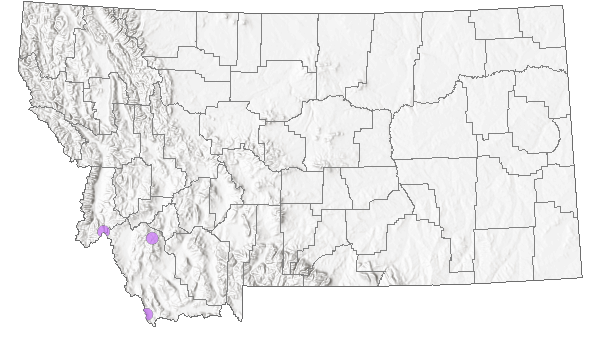
 Native
Native
Range Comments
Beaverhead County. OR to MT south to CA, AZ and WY (Lesica et al. 2012. Manual of Montana Vascular Plants. BRIT Press. Fort Worth, TX).
Observations in Montana Natural Heritage Program Database
Number of Observations: 3
(Click on the following maps and charts to see full sized version)
Map Help and Descriptions
Relative Density
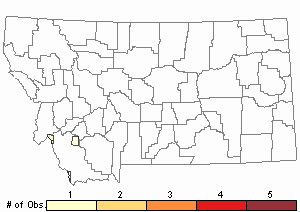
Recency
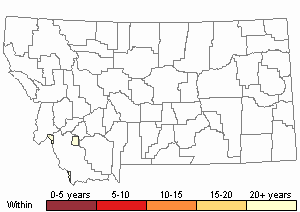
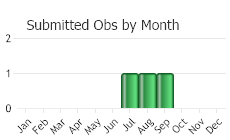

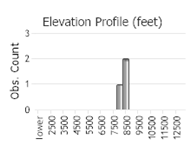 (Observations spanning multiple months or years are excluded from time charts)
(Observations spanning multiple months or years are excluded from time charts)
Habitat
Open limestone slopes in the upper montane zone.
National Vegetation Classification System Groups Associated with this Species
Grassland
Montane - Subalpine Grassland
Ecology
POLLINATORS The following animal species have been reported as pollinators of this plant species or its genus where their geographic ranges overlap:
Bombus bifarius,
Bombus centralis,
Bombus fervidus,
Bombus flavifrons,
Bombus huntii,
Bombus melanopygus,
Bombus mixtus,
Bombus rufocinctus,
Bombus occidentalis, and
Bombus insularis (Thorp et al. 1983, Wilson et al. 2010, Colla and Dumesh 2010, Koch et al. 2012).
Stewardship Responsibility
Threats or Limiting Factors
STATE THREAT SCORE REASON
Threat impact not assigned because threats are not known (MTNHP Threat Assessment 2021).
References
- Literature Cited AboveLegend:
 View Online Publication
View Online Publication Colla, S.R. and S. Dumesh. 2010. The bumble bees of southern Ontario: notes on natural history and distribution. Journal of the Entomological Society of Ontario 141:39-68.
Colla, S.R. and S. Dumesh. 2010. The bumble bees of southern Ontario: notes on natural history and distribution. Journal of the Entomological Society of Ontario 141:39-68. Koch, J., J. Strange, and P. Williams. 2012. Bumble bees of the western United States. Washington, DC: USDA Forest Service, Pollinator Partnership. 143 p.
Koch, J., J. Strange, and P. Williams. 2012. Bumble bees of the western United States. Washington, DC: USDA Forest Service, Pollinator Partnership. 143 p. Lesica, P., M.T. Lavin, and P.F. Stickney. 2012. Manual of Montana Vascular Plants. Fort Worth, TX: BRIT Press. viii + 771 p.
Lesica, P., M.T. Lavin, and P.F. Stickney. 2012. Manual of Montana Vascular Plants. Fort Worth, TX: BRIT Press. viii + 771 p. MTNHP Threat Assessment. 2021. State Threat Score Assignment and Assessment of Reported Threats from 2006 to 2021 for State-listed Vascular Plants. Botany Program, Montana Natural Heritage Program, Helena, Montana.
MTNHP Threat Assessment. 2021. State Threat Score Assignment and Assessment of Reported Threats from 2006 to 2021 for State-listed Vascular Plants. Botany Program, Montana Natural Heritage Program, Helena, Montana. Thorp, R.W., D.S. Horning, and L.L. Dunning. 1983. Bumble bees and cuckoo bumble bees of California (Hymenoptera: Apidae). Bulletin of the California Insect Survey 23:1-79.
Thorp, R.W., D.S. Horning, and L.L. Dunning. 1983. Bumble bees and cuckoo bumble bees of California (Hymenoptera: Apidae). Bulletin of the California Insect Survey 23:1-79. Wilson, J.S., L.E. Wilson, L.D. Loftis, and T. Griswold. 2010. The montane bee fauna of north central Washington, USA, with floral associations. Western North American Naturalist 70(2): 198-207.
Wilson, J.S., L.E. Wilson, L.D. Loftis, and T. Griswold. 2010. The montane bee fauna of north central Washington, USA, with floral associations. Western North American Naturalist 70(2): 198-207.
- Additional ReferencesLegend:
 View Online Publication
View Online Publication
Do you know of a citation we're missing? Lesica, P., M.T. Lavin, and P.F. Stickney. 2022. Manual of Montana Vascular Plants, Second Edition. Fort Worth, TX: BRIT Press. viii + 779 p.
Lesica, P., M.T. Lavin, and P.F. Stickney. 2022. Manual of Montana Vascular Plants, Second Edition. Fort Worth, TX: BRIT Press. viii + 779 p. Lesica, P., P. Husby, and S. V. Cooper. 1998. Noteworthy collections: Montana. Madrono 45:328-330.
Lesica, P., P. Husby, and S. V. Cooper. 1998. Noteworthy collections: Montana. Madrono 45:328-330.
- Web Search Engines for Articles on "Slender Fleabane"





